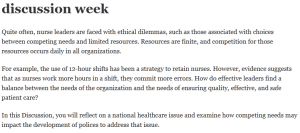discussion week

Quite often, nurse leaders are faced with ethical dilemmas, such as those associated with choices between competing needs and limited resources. Resources are finite, and competition for those resources occurs daily in all organizations.
For example, the use of 12-hour shifts has been a strategy to retain nurses. However, evidence suggests that as nurses work more hours in a shift, they commit more errors. How do effective leaders find a balance between the needs of the organization and the needs of ensuring quality, effective, and safe patient care?
In this Discussion, you will reflect on a national healthcare issue and examine how competing needs may impact the development of polices to address that issue.
To Prepare:
· Review the Resources and think about the national healthcare issue/stressor you previously selected for study in Module 1.
· Reflect on the competing needs in healthcare delivery as they pertain to the national healthcare issue/stressor you previously examined.
By Day 3 of Week 3
Post an explanation of how competing needs, such as the needs of the workforce, resources, and patients, may impact the development of policy. Then, describe any specific competing needs that may impact the national healthcare issue/stressor you selected. What are the impacts, and how might policy address these competing needs? Be specific and provide examples
Then have to respond to two peers and at least 2 references
Peer one
Healthcare providers such as nurses usually face ethical dilemmas, especially when they do not know what to choose between competing needs and scarce resources. Such dilemmas exacerbate national health care issues such as health inequalities. This paper discusses how competing needs may affect the development of policy and the issue of health inequalities.
In the US, policies such as Triage policies have been developed to help distribute scarce resources to patients. The resources include beds, healthcare staff, ventilators, and other life-saving resources. However, the scarcity of healthcare resources is likely to impede such policies’ capability to fulfil their obligations. For example, through the principle of social usefulness, patients with the greatest potential value to society are prioritized. In other cases, the distribution of the limited resources is based on a first-come-first-serve basis (Buckwalter & Peterson, 2020). These distribution principles create dilemmas in the policy. These dilemmas affect the development of policies that promote equitable distribution of policies.
Competing resources also affect the issue of health inequalities by making it worse. Miller et al. (2020) argued that scarce resource allocation is likely to exacerbate the problem of racial disparities in healthcare. Marginalized communities are likely to suffer from disproportionate allocation of resources during a public health emergency. This is because there is no balance between proposed principles for allocating resources to individuals who are most likely to benefit from them. For example, in the case of Covid-19, a question may arise as to who is more exposed or who should be prioritized. Therefore, this challenge of competing resources might be addressed by developing policies that specifically address structural barriers and limitations (Assari, 2018).
Peer 2
Competing Needs and their Impact on Policy Development
Policy development is usually based on the needs of the patient, the needs of the institution, and the needs of the staff. Most times policies are implemented as a reaction to an event or several events that may have occurred and negatively impacted patient and/or staff outcomes. Korownyk et al. (2017) stated that nurse and provider shortages should be the top priorities addressed by a facility as addressing healthcare shortages will positively impact policy development. Stabilizing the nurse and provider shortages is most important as this would create a solid foundation to yield positive results in other areas (i.e., better patient outcomes, increased revenue, increased staff retention, etc.).
National Healthcare Issue
The nursing shortage is nothing new and will continue to worsen as the population ages and the demands of the workforce increase. The competing needs in the nursing shortage include a lack of resources (specifically ancillary staff) coupled with the delivery of quality care given to patients. According to Saban et al. (2019), there is an expectation that nurses must provide high-quality healthcare while promoting patient safety and patient satisfaction. While the delivery of high-quality healthcare is important, the nursing shortage can limit the kind of care that is given to patients. Nurse-patient ratios have increased and there is fewer ancillary staff to aid in the delivery of care. Nurses are spending less and less time with their patients because of the extra workload and demands for care delivery.
Impact of Policy
All hospitals should have strict policies on nurse-patient ratios, especially when there are such severe nursing shortages. Such policies would allow nurses to provide high-quality care, reduce burnout, and build morale. According to Haddad et al. (2022), nursing shortages lead to errors, higher morbidity/mortality rates, and dissatisfaction with services, however in hospitals with policies that limit nurse-patient ratios, all the above-listed negative impacts occur at a much lower rate. The nurses, although short-staffed, are able to deliver better care and feel less overwhelmed by the demands of the profession.